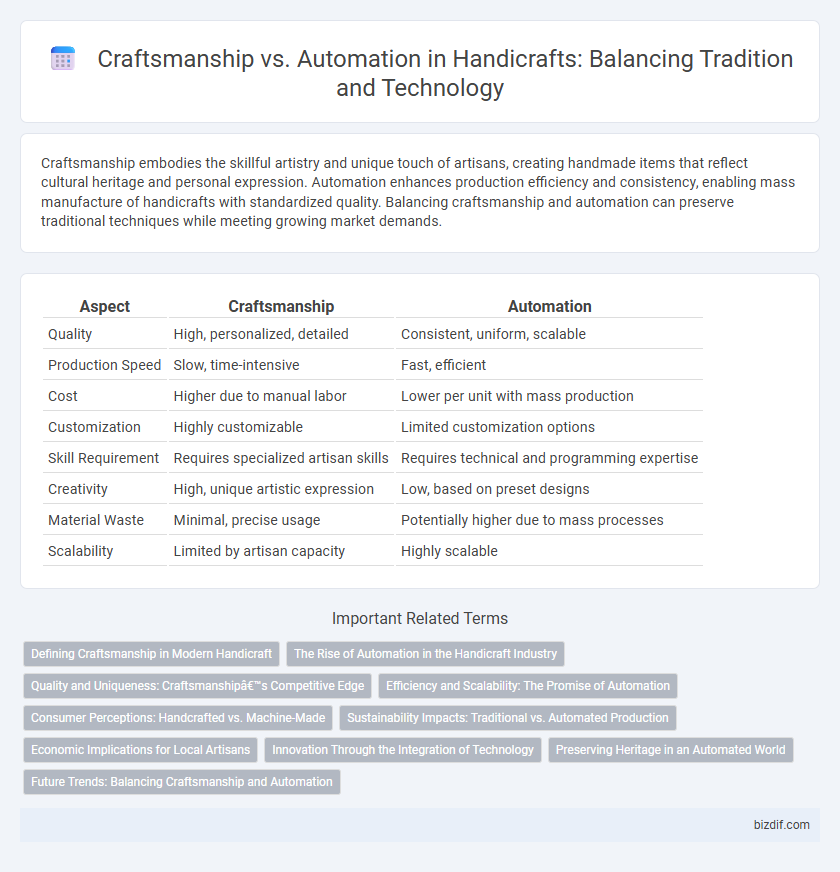Craftsmanship embodies the skillful artistry and unique touch of artisans, creating handmade items that reflect cultural heritage and personal expression. Automation enhances production efficiency and consistency, enabling mass manufacture of handicrafts with standardized quality. Balancing craftsmanship and automation can preserve traditional techniques while meeting growing market demands.
Table of Comparison
| Aspect | Craftsmanship | Automation |
|---|---|---|
| Quality | High, personalized, detailed | Consistent, uniform, scalable |
| Production Speed | Slow, time-intensive | Fast, efficient |
| Cost | Higher due to manual labor | Lower per unit with mass production |
| Customization | Highly customizable | Limited customization options |
| Skill Requirement | Requires specialized artisan skills | Requires technical and programming expertise |
| Creativity | High, unique artistic expression | Low, based on preset designs |
| Material Waste | Minimal, precise usage | Potentially higher due to mass processes |
| Scalability | Limited by artisan capacity | Highly scalable |
Defining Craftsmanship in Modern Handicraft
Craftsmanship in modern handicraft emphasizes the skilled manual creation of unique, high-quality products that reflect personal artistry and cultural heritage. Unlike automation, which prioritizes efficiency and mass production, craftsmanship values attention to detail, creativity, and the tactile connection between maker and material. This approach sustains traditional techniques while adapting to contemporary design trends, sustaining the authenticity and individuality of handmade goods.
The Rise of Automation in the Handicraft Industry
The rise of automation in the handicraft industry has revolutionized production by integrating advanced robotics and AI technologies to enhance efficiency while preserving traditional artistry. Automated systems enable mass customization and consistent quality control, reducing manual labor and production time in sectors such as textile weaving, pottery, and wood carving. Despite automation's growth, the industry's emphasis on handcrafted uniqueness remains critical to maintaining cultural heritage and market value.
Quality and Uniqueness: Craftsmanship’s Competitive Edge
Craftsmanship offers unparalleled quality through meticulous attention to detail and skilled handwork, creating unique pieces that mass-produced automation cannot replicate. The intrinsic value of handcrafted items lies in their distinct imperfections and personalized touches, which appeal to consumers seeking authenticity. Automation excels in consistency and volume but falls short in delivering the bespoke character and artisanal excellence that define superior craftsmanship.
Efficiency and Scalability: The Promise of Automation
Automation in handicraft significantly boosts efficiency by streamlining repetitive tasks, enabling faster production cycles without compromising precision. Scalability becomes achievable as automated systems handle larger volumes with consistent quality, surpassing the limitations of manual craftsmanship. This technological integration promises enhanced output capacity while maintaining the intricate details that define artisanal products.
Consumer Perceptions: Handcrafted vs. Machine-Made
Consumers often perceive handcrafted products as more authentic, unique, and of higher quality compared to machine-made items, which are seen as mass-produced and less personal. The tactile imperfections and detailed artistry in handmade goods evoke emotional connections and cultural value that automated manufacturing typically lacks. Despite automation's efficiency and scalability, many buyers prioritize the traditional skill and craftsmanship embodied in handcrafted crafts for their originality and storytelling appeal.
Sustainability Impacts: Traditional vs. Automated Production
Traditional craftsmanship emphasizes sustainable practices by utilizing local, natural materials and minimizing waste through skilled manual techniques. Automated production often relies on synthetic materials and energy-intensive machinery, leading to higher carbon footprints and resource depletion. Sustainable handicraft supports circular economy principles, preserving cultural heritage while reducing environmental impact compared to mass-produced automated goods.
Economic Implications for Local Artisans
Local artisans rely on craftsmanship to preserve cultural heritage and create unique, high-value products that attract niche markets willing to pay premium prices. Automation processes can reduce production costs and increase output but often lead to job displacement and loss of traditional skills within artisan communities. Balancing technological integration with support for handmade goods is essential to sustain local economies and maintain artisans' economic viability.
Innovation Through the Integration of Technology
Craftsmanship in the handicraft sector evolves by integrating advanced technologies such as 3D printing, CNC machining, and augmented reality, which enhance precision and broaden creative possibilities. Automation streamlines repetitive tasks, allowing artisans to focus on intricate design elements and customize products with greater efficiency. This fusion of traditional skills and cutting-edge innovations fosters unique, high-quality handcrafted items while maximizing productivity and market adaptability.
Preserving Heritage in an Automated World
Craftsmanship preserves cultural heritage by maintaining traditional skills and artisanal techniques that automation cannot replicate, ensuring the uniqueness and authenticity of handmade products. Automated production boosts efficiency but often sacrifices the intricate details and soulful expressions embedded in handcrafted items. Balancing technology with skilled artisans protects heritage while embracing modern advancements in handicraft industries.
Future Trends: Balancing Craftsmanship and Automation
Future trends in handicraft highlight a strategic balance between traditional craftsmanship and automation, integrating advanced technologies like AI and robotics to enhance precision while preserving artisan authenticity. Emphasis on sustainable materials and bespoke designs ensures handcrafted uniqueness remains at the forefront even as automated processes increase efficiency and scale. Craftsmanship's future lies in hybrid models where human creativity and machine innovation coalesce to meet evolving consumer demands for quality and customization.
Craftsmanship vs Automation Infographic

 bizdif.com
bizdif.com